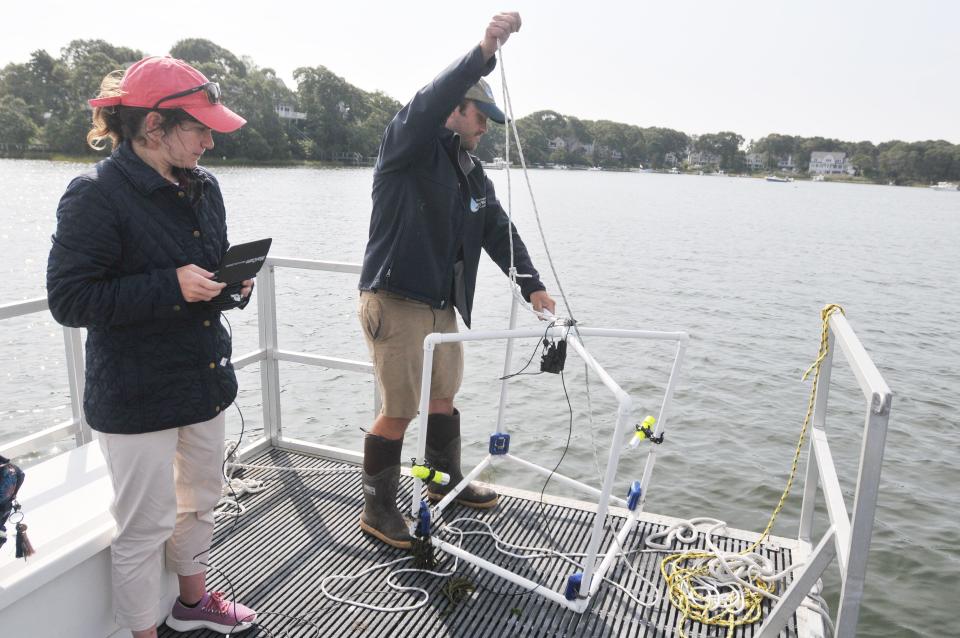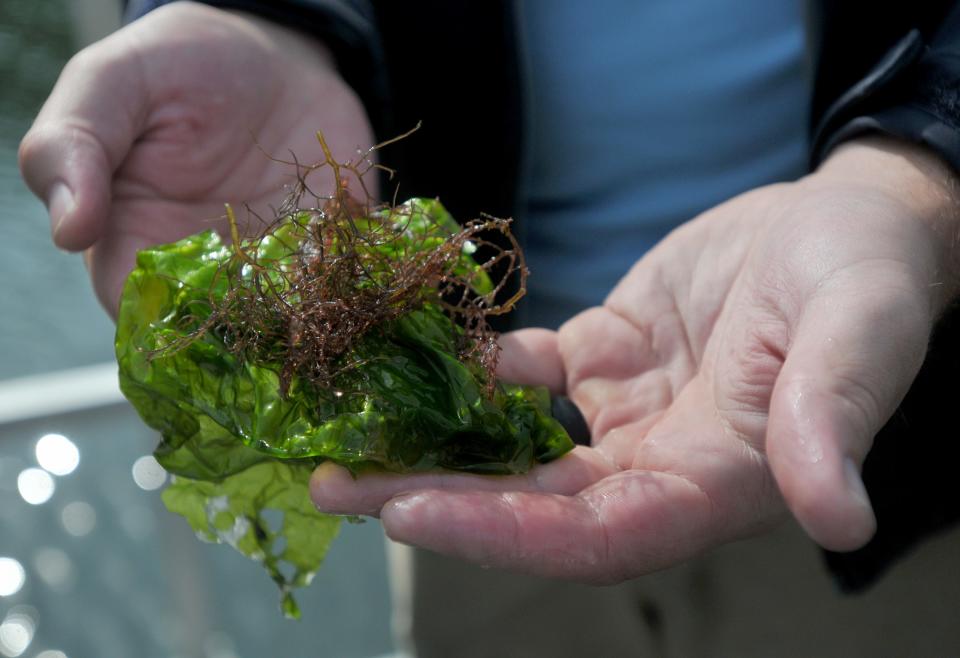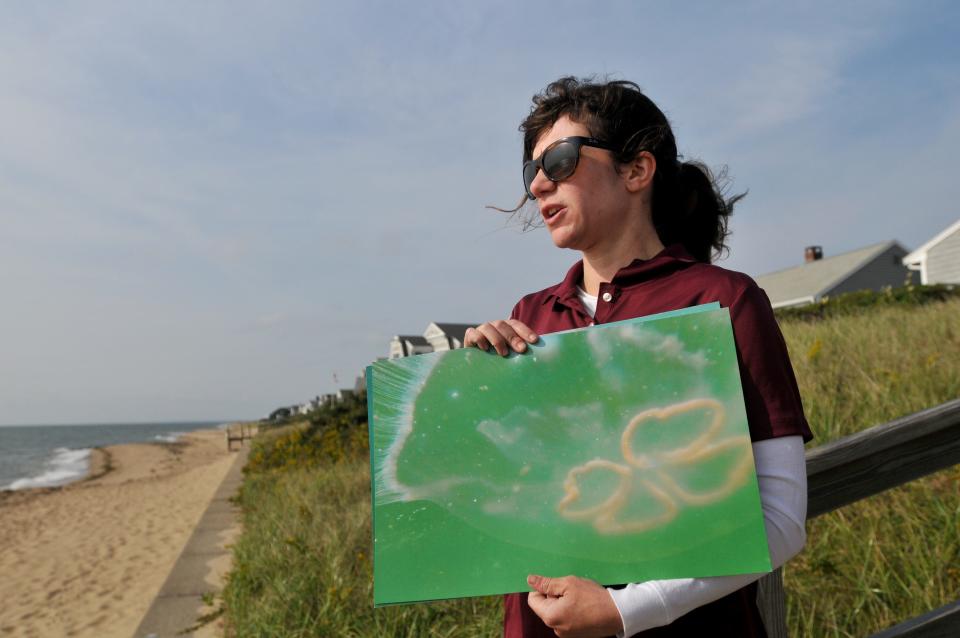Cape Cod researcher studies how water quality, warming may affect seaweed, jellyfish
POPPONESSET BAY — Standing at the edge of a converted pontoon boat anchored in Popponesset Bay, environmental researcher Nicole Corbett held a small monitor as Barnstable Clean Water Coalition field operations manager Luke Cadrin lowered a scientific instrument array attached to a length of rope into the dark water.
The 25-pound benthic rig fashioned from PVC pipes and weights carried a video camera and two lights to the shallow bottom. Corbett, of the Popponesset Water Stewardship Alliance, peered at the monitor where a real-time video from the camera was displayed, then showed it to Cadrin.
"There's Gracilaria and there's dead Codium on top," she said, pointing out the invasive red algae and seaweed observed at the bottom.
It wasn't an encouraging sight. Nor was the clump of smelly, black sludge — a compaction of decomposed algae and seaweed — that came up when Cadrin pulled up the anchor.

For the past few years, Corbett has undertaken a study of invasive seaweed species in waters around Mashpee and Barnstable, looking at how nutrient enrichment from septic systems and runoff down the Mashpee River and in Ockway and Popponesset bays may be affecting accumulations of drift algae and seaweed along the beaches on Nantucket Sound. She's also investigating the causes and species involved with more frequent and longer-lasting jellyfish blooms, and whether they are related to the water quality.
She recently applied for federal nonprofit status for the Popponesset Water Stewardship Alliance, formed in 2021, to support the efforts. A science teacher at Abington High School who's spent many summers in and around the waters of Mashpee, Corbett is helped by volunteer citizen scientists living near Popponesset Beach, as well as students.
She also collaborates with fellow scientsts, including Amy Costa from the Center for Coastal Studies — who helped design a water testing program for Popponesset Beach and processes samples — along with Jennifer Dijkstra from the University of New Hampshire, Donald Anderson of the Woods Hole Oceangraphic Institution, and Brian Lapointe of Florida Atlantic University.
"There's quite a few invasives now," Corbett said as she and Cadrin, with whom she also works, examined strands of invasive seaweed brought up on the instrument rig during a recent outing. "At least half the species we are finding are nuisance species, invasive species, or species that have been migrating up from the south."
Worrisome at the bottom of Cape Cod's waters
It's worrisome, she said, because the bottom of Cape Cod's waters "is the foundation of the ecosystem."
"Historically this would have been eelgrass beds," Cadrin said, who pilots the pontoon, during a stop near the mouth of the Mashpee River. "We would like to get back to a place where eelgrass is growing again. But that's a long way away."
Part of Corbett's goal, she said, "is to educate people about what's going on and give people a different perspective. A lot of people only see the water from the top."
She focuses mostly on the open waters of Nantucket Sound around Popponesset Spit, a barrier beach between Popponesset Bay and the Sound. The waters there have seen a lot of seaweed and algae drifts, as well as jellyfish in recent years, and Corbett wonders how much of that has to do with the nearby bay.
One of the most polluted areas in southeastern Massachusetts
"Popponesset Bay is one of the most polluted areas in southeastern Massachusetts," she said. "Locally, it's the worst."
Corbett's grandparents have had a house in the area since the 1950s and she's been in the water most of her life, she said. She's seen many changes.
"Around the late 2000s I started to notice a lot of seaweed drifting up and building up on the beach," she said. "We started to get some drifts of seaweed that were very, very thick in late summer. It rotted and turned black. It would smell really bad and create a hypoxic condition. It extended 150 feet off the shore."
At one point, she said, the drifts of seaweed made the water off Popponesset Beach appear blood red. In the winter of 2019, that same seaweed drifting around in the summer started to show up in December. It's called dasysiphonia japonica, a species that's native to Japan and China that's "gradually been making appearances along the northeast coastline," she said.
Spot the Dasy program begins
She said the seaweed, which for simplicity she just refers to as "Dasy," was the worst in 2020, in waters off Barnstable, in Popponesset Bay, and down to the shores of Falmouth. It inspired creation of the stewardship's "Spot the Dasy" program encouraging people to report sightings and send in photos of the seaweed — Abington High School graduate Kaylee Donaher helped get it going by uploading photos sent to the team, which includes Corbett's collaborating fellow scientists, onto an interactive map.
The trouble with Dasy is its prolific reproductive ability. As it drifts, she said, "it's still able to reproduce. It releases thousands of spores."

She's looking to investigate how Dasy blooms, as well as blooms of Codium fragile, another invasive Asian seaweed called that's been observed here for about 50 years now, might correlate with nutrient enrichment and climate changes. In the past, Dasy has dropped off around February, but this year it persisted into spring and summer.
A tandem study of jellyfish
Corbett's tandem study of jellyfish is something she "fell into" in the course of her seaweed observations. Changes in the ecosystem have brought swarms of moon jellies — some of them a foot across — as well as jellyfish species normally occurring farther south.
"In 2018, I was swimming along to get around the seaweed. There was this Atlantic bay nettle tangled up in the seaweed, and I got the tentacles all wrapped around my arm," Corbett said, recollecting the encounter that landed her in the hospital.
This jellyfish is a newer species here, she said, "that's been gradually migrating up the coastline and establishing itself." The jelly is normally associated with the Chesapeake Bay area, but the warming waters of the northwest Atlantic — one of the fastest warming bodies of water on Earth — are giving it new territory to inhabit.
A jellyfish sting kit program starts in 2021
In 2021, a jellyfish sting kit program was started: A team effort involving Sophia Loconto from Boston Latin School, Leo Romanski from North Reading High School and Lidia Vidal, an Abington High School graduate and Massasoit Community College graphic design major who designed the artwork on the exterior of some of the kits, as well as the stewardship's t-shirts and website illustrations.
Through the program, kits containing spray and cream, in addition to a hot pack, are placed at various spots along Popponesset Beach — Corbett explained that the hot pack is included because heat helps break down jellyfish venom. This year, some kits were also distributed to the Craigville Beach area, and Corbett said she'd like to expand the program to other beaches where jellyfish are becoming more common.
While moon jellies are thought to be non-stinging, she said people have reported receiving mild stings from them while swimming at local beaches. She experienced it herself. Corbett is curious to learn if there are some environmental conditions that have resulted in the moon jellies developing an irritating mucous or other ability to sting. She's collected tissue samples for testing, she said, noting she's collaborating with scientists at the University of Hawaii on that part of her investigation.
Moon jellies have been prevalent since about 2007, she said, and the bay nettles began showing up around 2016.
"This year was the worst jellyfish year by far," Corbett said. "Some of them have gotten to be about four times bigger than what we've been seeing, and they came out earlier than usual."
Moon jellies can reach up to 12 inches in diameter
Moon jellies have been observed to reach up to 12 inches in diameter, and some of the bay nettles are measuring four feet long with eight-inch diameter bells. Corbett's question is whether rising water temperature, or a nutrient problem, or a combination of both, are making the jellyfish bigger and causing them to show up earlier and stay longer. One theory is that Popponesset Bay may be serving as a jellyfish nursery.

As part of her research, she said, she's interested in getting to know Popponesset Bay and Ockway Bay better. Besides the Dasy and Codium, there is a lot of Ulva, also known as sea lettuce, found in these water bodies — a species that thrives even in polluted water. It dies off in the winter and decomposes, adding to the thickening layer of malodorous sludge on the bay floor.
Like Corbett, Cadrin said he's seen many concerning changes. He grew up on the Cape and said he has observed the water quality "definitely declining."
As the invasive seaweeds and algae decompose, he said, "it's taking oxygen out of the water," and "if there's too low oxygen here, things like shellfish can't survive."
Developing filtering oyster beds can help. The Mashpee Wampanoag Tribe in Mashpee has developed oyster beds, and the town of Mashpee is looking to put one at the mouth of the Mashpee River. But Corbett and Cardin agree addressing the issue will require a robust sewering plan, too.
"Cape Cod is beautiful on the surface. It's really what's under the water that tells a different story. I think communicating that is really key," Corbett said. "What the end game is, what the end result is, we don't know. But we are concerned about it. A lot of things have been happening gradually over the past 50 to 60 years, but a lot of things have also happened very rapidly over the last 10 years or so."
Heather McCarron writes about climate change, environment, energy, science and the natural world, in addition to news and features in Barnstable and Brewster. Reach her at hmccarron@capecodonline.com.
Thanks to our subscribers, who help make this coverage possible. If you are not a subscriber, please consider supporting quality local journalism with a Cape Cod Times subscription. Here are our subscription plans.
This article originally appeared on Cape Cod Times: Cape Cod researcher studies water quality effects on seaweed, jellies

